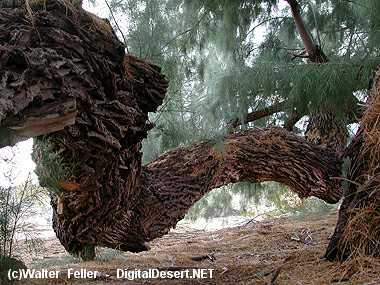Fire and Weeds
Fires historically were not common in the Mojave Desert, and when they did occur, they did not spread rapidly or very
far. The natural spaces left between native desert plants usually kept fires under control. Today these spaces are
increasingly filled by nonnative grasses, such as cheat-grass (Bromus tectorum) and red brome (Bromus rubens), which
remain rooted after they die, creating an uninterrupted fuel source for fires. (By contrast, native desert annuals
crumble and blow away after they die.) Nonnative grasses also are the first to emerge after a fire, giving them a
competitive edge. The result is weed-infested landscapes. In the Mojave, land managers now suppress fires when possible
to inhibit weed growth..
Tamarisk (Tamarix chinensis), another desert alien, is one of the most invasive shrub-trees in the southwestern
United States. Also known as saltcedar, it destroys riparian habitats, taking in great amounts of water and depositing
salt into the soil. The plant also fuels fires with its large masses of dry branches and leaves. After a fire it quickly
re-sprouts and easily out-competes native plants because of the salt it has deposited into the soil. Tamarisk also has an
advantage because the Mojave's native cottonwood and willow trees need periodic floods to survive, a natural process that
has been virtually eliminated by modern water control projects. Most riparian areas in the desert are therefore dominated
by tamarisk.
Complicating removal of tamarisk is the situation of the endangered southwestern willow flycatcher
(Empidonax traillii extimus), a bird that has turned to the tamarisk for shelter because of the destruction of its
native cottonwood and willow habitat. This poses a special challenge for managers, who must take care not to disturb
this endangered species as tamarisk is removed.
< Previous - Overview of the Mojave >

Overgrown tamarisk branch